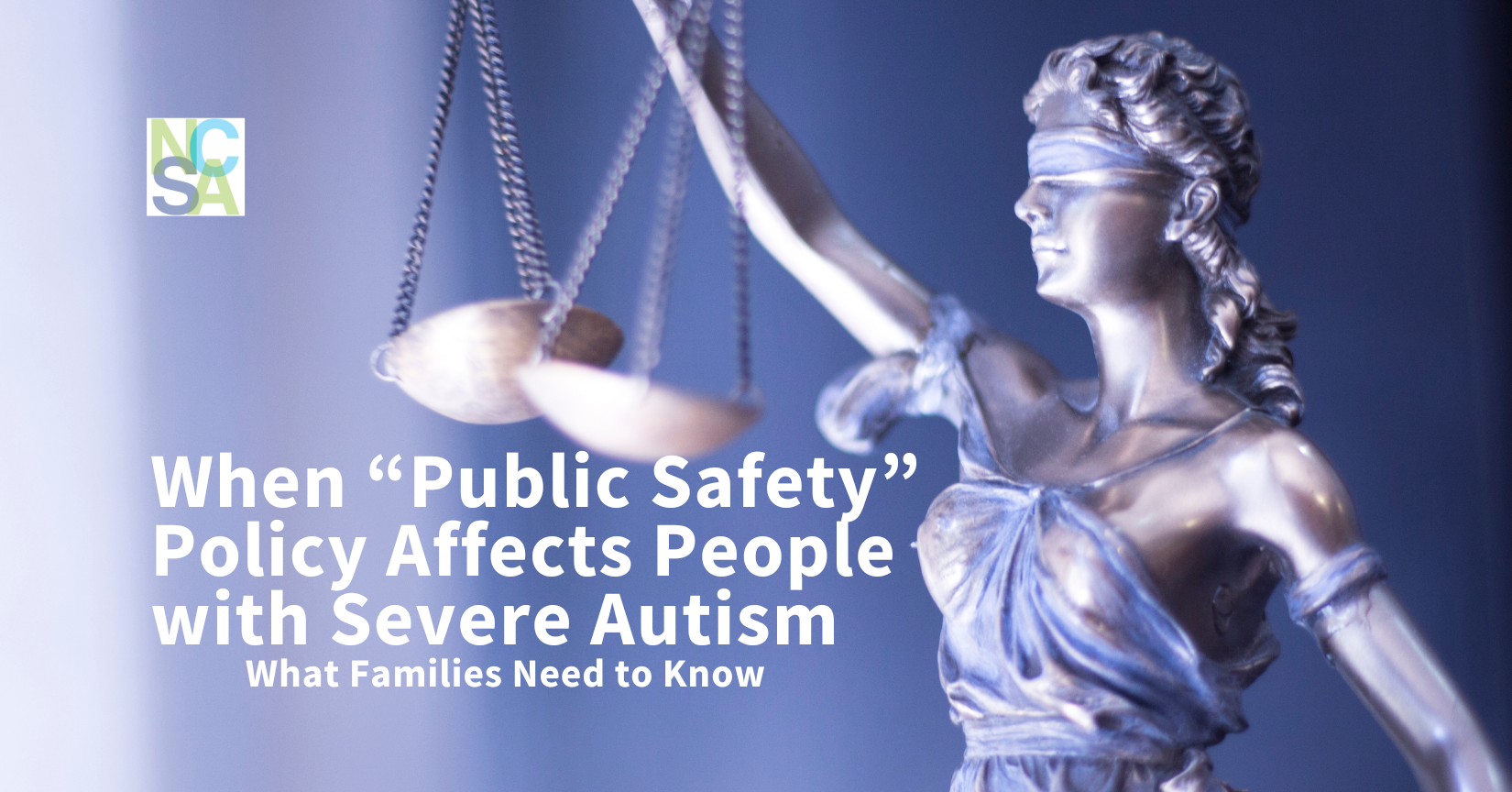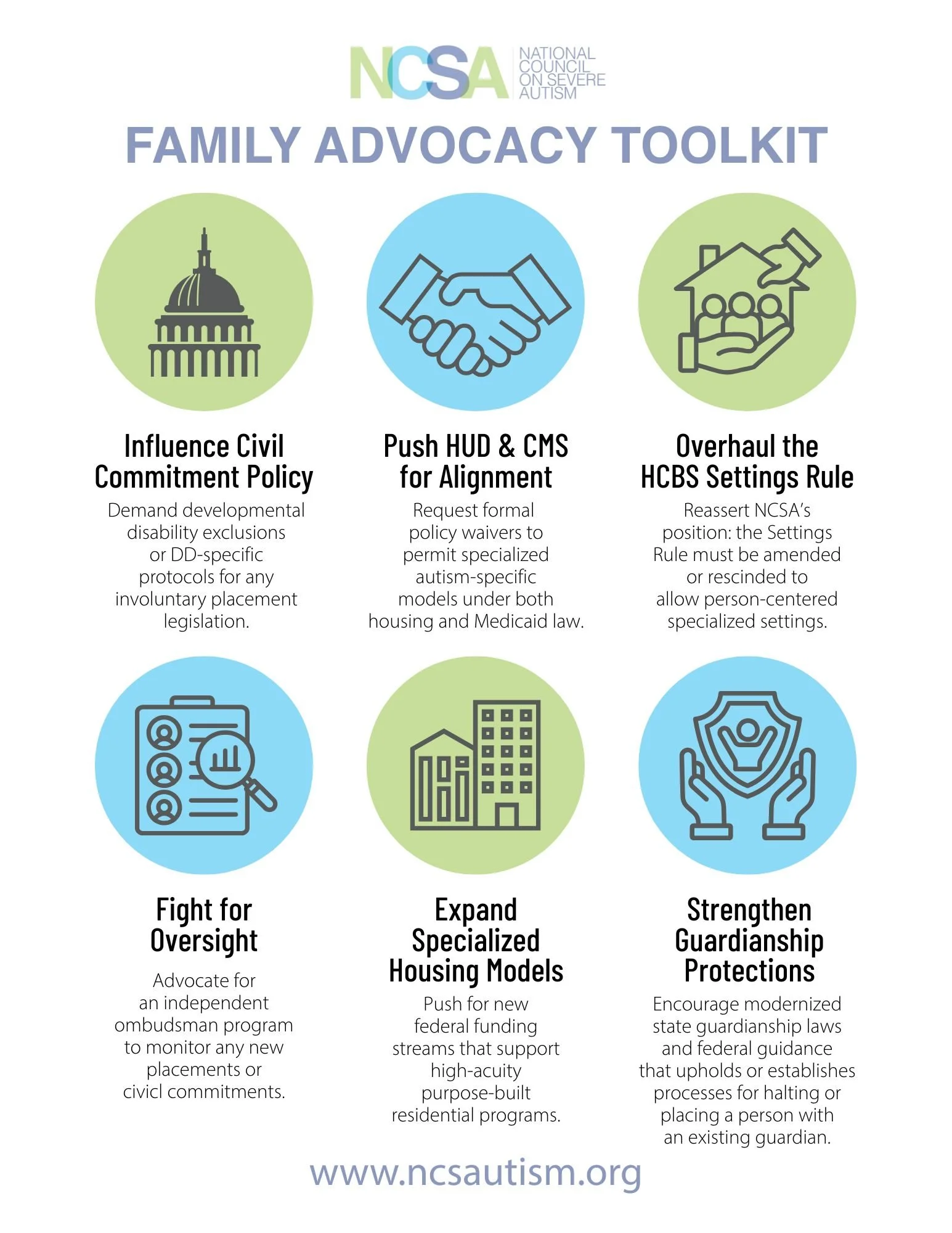By Jackie Kancir, NCSA Executive Director
____________________________________
On July 24, the White House released an Executive Order titled “Ending Crime and Disorder on America’s Streets.” While its focus is on homelessness, mental illness, and public safety, many of the proposed actions could have serious — and (hopefully) unintended — consequences for individuals with severe autism and their families.
While acknowledging risk, there may also be potential for improvements in systems of support for our loved ones, too. If implemented wisely and with the right safeguards, this Executive Order (EO) could also offer a unique opportunity to fix what’s long been broken.
What the EO Says — and Why It Matters to Us
The EO calls for:
Expanded civil commitment laws for individuals who “cannot care for themselves” or “pose a danger to others”
A shift away from Housing First models in favor of treatment-linked housing
New federal grants to encourage states to enforce vagrancy laws and move people off the streets
A review of HUD and HHS regulations to align them with “treatment-focused” approaches
That language might seem far removed from the lives of families caring for individuals with severe autism, intellectual disability, and severe behavior, but here’s the reality:
Many of our loved ones can’t access group homes because of aggressive behavior, or when they do, they suffer traumatic abuse.
HCBS waivers are often approved but unstaffed
Emergency rooms have become holding cells when families are in crisis
Police are sometimes the only available responders, and that’s dangerous
This Executive Order, for all its flaws, finally admits something NCSA has long said: that for some individuals, 24/7 structured care is medically necessary, and we have no system to provide it.
Concerns
Here’s the risk: if these new powers are implemented broadly, without disability-specific safeguards, individuals with severe autism could be swept into punitive systems.
For example:
A nonverbal adult pacing, screaming, or bolting in public could be perceived as “dangerous”
A person exhibiting self-injury might be civilly committed under a psychiatric standard that doesn’t fit
Guardians could lose legal decision-making power under vague definitions of “risk”
Programs that center on law enforcement rather than care could criminalize behaviors rooted in neurological disability
We have to be clear: severe autism is not a crime. The aggressive or self-injurious behaviors some individuals exhibit are not acts of intent. There is no “mens rea” (no desire to harm). These are symptoms of pain, distress, and unmet need.
With proper supports — medical care, behavioral therapy, environmental adaptations — many can live safely and meaningfully in a variety of settings that meet their preferences, but they are currently being left behind.
Potential Opening for Dialogue on Improved Systems
If we move quickly and effectively, this EO can be leveraged to:
Advocate for Medicaid-funded residential models that match the complexity of severe autism
Push CMS to revise the HCBS Settings Rule, which states use to block person-centered, autism-specific housing
Establish disability-competent pathways for civil commitment that are therapeutic, not carceral
Build capacity for purpose-built housing models that incorporate clinical and behavioral support
Demand independent oversight and legal protections for those affected by any new policies
This isn’t about nostalgia for institutions. It’s about the right to build something better and the opportunity to do it now.
What Families Can Do
Read my analysis: Click here to view my breakdown of the EO.
Read our Hill Briefing: Click here to view our message to Congress. Share this with your legislators!
Share your story with elected officials. Tell them how the system has failed your loved one, but also tell them what would work for your loved one instead. Be a source of support for your legislators in developing meaningful solutions.
Watch for action alerts from NCSA in the coming weeks. We’ll be submitting comments and proposals to key federal agencies.
Talk to local journalists. Help shift the narrative from “dangerous” to “unsupported.” Send letters to the editors of your local papers.
Strengthen Guardianship Protections.
Encourage state legislation to modernize guardianship systems, ensuring both the empowerment of dedicated family guardians and robust accountability mechanisms to prevent misuse or neglect.
Advocate for federal guidance that prevents emergency holds or civil commitments from overriding existing guardianship without due process.
You can download our Family Advocacy Toolkit to keep in front of you when speaking to legislators to help remember the key talking points. Share it on your social networks and help spread the word of how we can build a better future for our children. Find more policy document downloads here.
Final Word
This Executive Order wasn’t written for our children, but it may finally give us a seat at the table. With coordinated, level-headed, well-informed, collaborative advocacy, we can ensure that “public safety” doesn’t become an excuse for surveillance, confinement, or neglect. It becomes an invitation to build real care.
Let’s use this moment to redefine what safe, appropriate, and person-centered really means.







